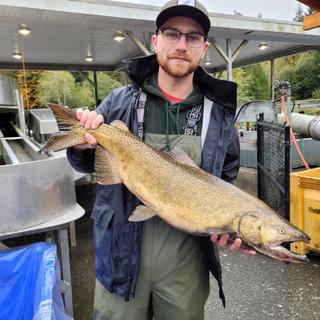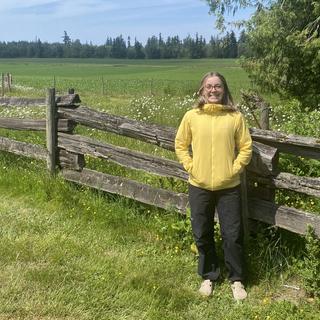Alum’s undergrad research published in an international journal
VIU alum Mac Barrera’s undergraduate research was not only published in an international journal, it has also led to new insights about the endangered Vancouver Island marmot.
“It’s exciting. I feel very proud,” says Mac, who now works as a lab technician in VIU’s Biology department. “Getting an undergrad research paper published in a legitimate, peer-reviewed journal is rare.”
Mac’s paper was published in the International Journal for Parasitology: Parasites and Wildlife and is co-authored by VIU professors Drs. Jamie Gorrell and Jasmine Janes.
“Jamie and Jasmine are creating this program at VIU where students can do real hands-on research and get fundamental laboratory and report writing skills,” says Mac. “They’re active in research and keen on having their students take hold of the process.”
Mac also worked on the manuscript submission, including responses to peer review. undergraduate students seldom get the opportunity to go through the whole process.
“It was an incredible opportunity to be able to do that. It was a lot of hard work, but in the end, it was all extremely worth it. I’m so grateful for that,” says Mac.
Mac, who graduated with a double major in Biology and Psychology, started his undergraduate research journey at VIU with his Biology 491 project. He worked as a summer research assistant for Jamie for three summers. Mac encourages students to apply for the summer work terms to gain hands-on experience.
“Over the course of my 491, I built a set of laboratory and analytical skills that laid the foundation for my career as a laboratory scientist,” says Mac. “Over the next two summers, I contributed to several projects, adding additional lab, data and communication expertise to my toolkit.”
Mac worked with Jamie to build a genomic DNA catalogue for the Vancouver Island marmot and began an ongoing study on the population genetics of Canada lynx, among several other small projects.
“This experience has led to more opportunities than I ever could have imagined. All of this was made possible by the resources, guidance and support that Jamie invested in my training,” says Mac. “The program of student research that he, Jasmine and others are building at VIU is truly exceptional.”
What parasite genetics tell us about marmots
Mac examined the genetics of two Vancouver Island marmot parasites, a tapeworm and a nematode, commonly known as a roundworm. No research had been done on these two species before.
The tapeworm Mac studied is only found in Vancouver Island marmots. The roundworm lives in several other species of marmots and groundhogs. He compared the DNA to mainland parasites to determine if the ones found in Vancouver Island marmots were a unique species. Mac discovered that the tapeworm is unique. He could not confirm if the roundworm was because their sample population was too small to assess genetic differences between the roundworm found in Vancouver Island marmots and those found in other species on the mainland.
The parasites’ genetics can provide clues to the evolutionary history of the marmots themselves. Researchers can look at the parasites’ family tree and the levels of genetic divergence. Barrera says scientists have believed that the marmot colonized the island at one point and became a unique species and never left. But the genetics of the parasites add new insights into how marmots migrated.
“There has been evidence more recently that there were perhaps multiple migrations to the Island. There might have been an early ancient marmot species that died off and then the Island was re-colonized,” says Mac. “There could have been separate waves of migration from the mainland at different points.”
Mac says the parasites’ genetics are consistent with a hypothesis about multiple migrations because one parasite appears to have been evolving for a much longer time with the marmots. Further studies of the nematode across its complete host range may better resolve the history of its association with the VI marmot.
Read Mac’s research paper, Molecular phylogenetics and systematics of two enteric helminth parasites (Baylisascaris laevis and Diandrya vancouverensis) in the Vancouver Island marmot (Marmota vancouverensis).




